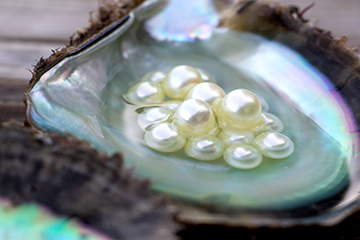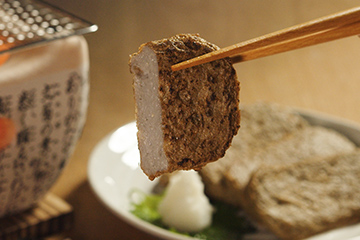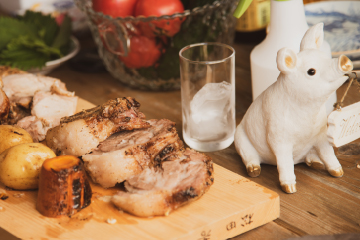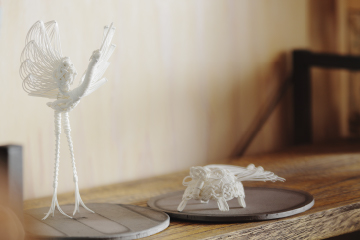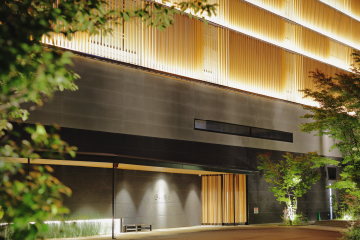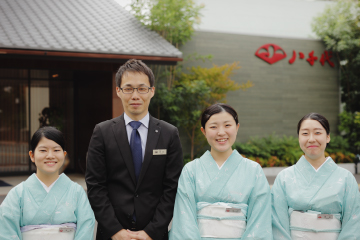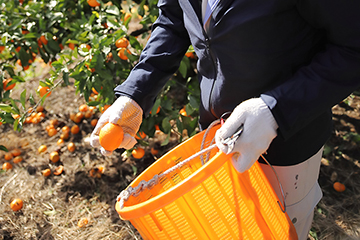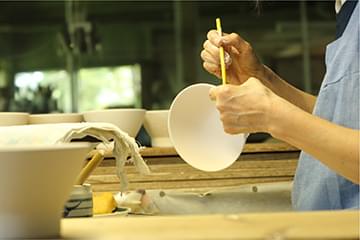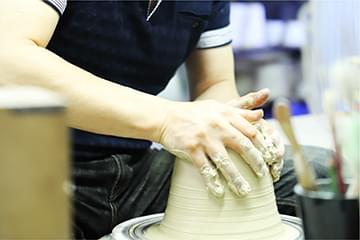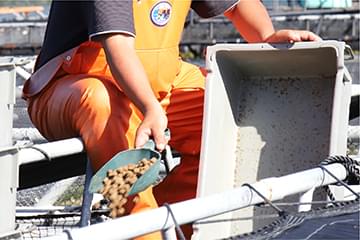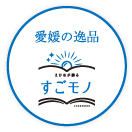“Jakoten”
Traditional Ehime superfood made by mincing freshly caught raw fish, bones and all.

Skilled artisans knead jakoten into the ultimate texture using a traditional stone mortar.
The first time you try jakoten, you may be surprised to find that it has the same crunchy texture as when you bite into dried fish. Jakoten is made from fresh raw fish that has been mashed down to the bone and skin. “That’s why it has a unique crunchy surface, and the surimi is full of richness and nutrition,” said Mr. Hajime Yasuoka, the second-generation owner of Yasuoka Kamaboko in Uwajima City. The company started out as a fish shop, and with a keen eye for detail, he carefully selects and blends the fish that will be used for jakoten by assessing the condition of the fish at the nearby market that day. During the production process, Mr. Yasuoka insists on using a traditional stone mortar to make “surimi”, or minced fish. “Using a stone mortar with a rough surface makes the ‘surimi’ finer and chewier, making it much tastier,” he says, explaining why he does not use the large mixes that many fish paste makers use for mass production. He insists on instead sticking to traditional handwork, which requires time and effort. After the fish paste is cooled to make it sticky, it is slowly and carefully milled. Then, egg whites are added to make it smooth, and finally it is fried in rapeseed oil to bring out the flavor of the fish.

The taste and unique texture of the jakoten made from the tastiest fish chosen each season is all thanks to the skills of the artisans. They use their fingers like high-definition sensors to instantly detect the condition of the “surimi” as they knead it.

Mr. Yasuoka says, “The traditional handwork, which is too complicated to write down in a manual, has been handed down from generation to generation, led by a factory manager with 40 years of experience. I want to continue making jakoten using local products, techniques and customs.”

Fresh small fish caught in the local waters are used to make “surimi” with their bones.
After taking the jakoten out of the package, simply sear it lightly, drizzle soy sauce over it, and top it with grated ginger according to your preference. When you take a bite, you can feel the richness of the fish in your mouth, and the freshness of the fish is so condensed in the jakoten that it is hard to believe that it is a processed food. “Our jakoten is made by grating freshly caught small fish including its bones,” said Mr. Noriaki Tanimoto, the fourth generation of Tanimoto Kamaboko founded in 1916. While many fish paste makers are shifting to frozen surimi from overseas due to the need for efficiency, Tanimoto Kamaboko still processes raw fish, which requires more time. Jakoten was originally a locally produced and locally consumed eco-friendly dish made with raw small fish called “zako” which were left unsold at the fish market, and then frying them. The taste of old-fashioned food, inherited from the traditional methods of local cuisine, may be considered a genuine fish dish that is slowly disappearing nowadays.

Tanimoto Kamaboko’s main store is in the Yawatahama area near the Yawatahama Market, one of the largest markets in western Japan that has supported the local fish food culture as a base for trawlers.

Tanimoto Kamaboko’s jakoten comes in two types with different kinds of fish as ingredients. The “Mukashi-zukuri Jakoten” has a rich taste blended with various small fish. The “Harambo Jakoten” has an elegant finish with a lot of firefly fish (commonly known as harambo).

The love for the traditional dish to this day continues to deepen its traditional tastes.
While many of the foods that claim to be local foods or local specialties are consumed as gifts, the jakoten of Ehime Prefecture is still loved by the locals. Many elderly people have their own favorite jakoten, and it is an indispensable part of the meals of the people of Ehime Prefecture. In the Uwajima area, where Yasuoka Kamaboko operates, information exchange among the approximately 40 kamaboko stores is very active, and there is a spirit of working together as a community to enhance the traditional taste of kamaboko beyond the boundaries of the stores. Mr. Yasuoka says, “I am reminded of the importance of receiving life from the sea when seeing the elder artisans carefully preparing the fish, and when selling face-to-face with customers. That is because jakoten is a local dish rooted in the area.” He says that he feels grateful that the 400-year-old fish paste culture from the Edo period continues to be the cornerstone of jakoten production. In order to pass on the tradition of jakoten to the next generation, the company holds various events such as hands-on jakoten making and factory tours.

The walls of the Yasuoka Kamaboko factory, newly built in May 2019, are decorated with warm-touch illustrations of traditional artisans at work. The factory has a complete safety system that is HACCP certified.

Yasuoka Kamaboko’s “Uwajima Jakoten” has the words “100% freshly caught small fish” on the package. Each store is said to have its own unique flavor, but Yasuoka Kamaboko’s jakoten is known for its “good elasticity and crunchiness,” and has many fans throughout Japan.

An easy and delicious ideal health food perfect to make up for the lack of fish consumption.
Blue-backed fish contains a good balance of nutrients that modern people need, like DHA and EPA proteins and calcium contained in small bones. However, since 2006, fish intake fell below meat intake for the first time, and ever since, the trend away from fish has been accelerating due to changes in dietary habits and the need for complicated cooking. Mr. Tanimoto, who has examined the nutritional content of jakoten’s products, says, “By grating fish bones, you can easily get plenty of nutrients from fish.” Tanimoto Kamaboko also insists on using sea salt, which is rich in minerals and potassium, as its only seasoning. Jakoten contains all the nutrients of fish, tastes good, and is easy to eat. Jakoten is a versatile food for modern people. Locals cook it not only for oden and hot pot dishes, but also as a substitute for meat in curry and stir-fries.

The appeal of jakoten is that it goes perfectly with all kinds of dishes, including main dishes, soups, and side dishes. The richness of the condensed fish will deepen the flavor of the dish.

Both delicious and nutritious because only fish caught that day are used.
Master craftsmanship here too!
Here are some of the amazing flavors of the kamaboko shops we visited.
Ehime’s fish paste culture has its roots in the Edo period (1603-1868), when Date Hidemune became the first lord of the Uwajima clan and brought Kamaboko artisans from Sendai with him. There are many variations of paste dishes, like the old saying “deep-fried is tempura, steamed is kamaboko, and baked is chikuwa,” says, and there are many other delicious products besides jakoten.
Tanimoto Kamaboko
-
![]() ①Yawata Shaomai (Conger, Sea Bream, Squid)
①Yawata Shaomai (Conger, Sea Bream, Squid)This luxurious seafood shumai is made with fish paste, a specialty of Ehime Prefecture. There are 4 shumai per pack, perfect for a family, and it can be conveniently prepared in a microwave oven. It is a popular product sold in high-end supermarkets nationwide.
-
![]() ② Jakoten In Range
② Jakoten In RangeTanimoto Kamaboko’s famous “Mukashi-zukuri Jakoten” is now microwavable. The vacuumed package allows for long-term storage without losing freshness or flavor.
Yasuoka Kamaboko
-
![]() ①Jakotsumire
①JakotsumireIt is made with a lot of the same harambo surimi used in jakoten. The more you cook it, the more the broth comes out. It can be used in soups or broths, and even cooked rice to enhance the richness and flavor! The bite-sized pieces make it easy to eat.
-
![]() ②Agemaki
②AgemakiAlong with jakoten, agemaki is Yasuoka Kamaboko’s most popular product that won the Minister of Agriculture, Forestry and Fisheries Award, the highest prize at the National Kamaboko Fair in 1988. The beautifully colored rolls made of high-quality kamaboko and fried bean curd wrapped in the shape of the Japanese letter “no” are perfect for special occasions such as Osechi (New Year’s traditional foods) and festivals.
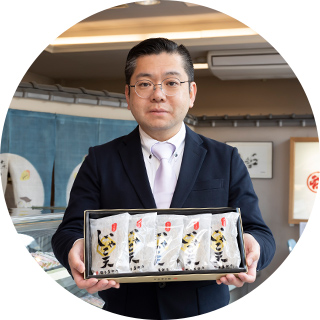 Fouth Generation Noriaki Tanimoto
Fouth Generation Noriaki TanimotoTel:0894-22-0266 Fax:0894-22-3162
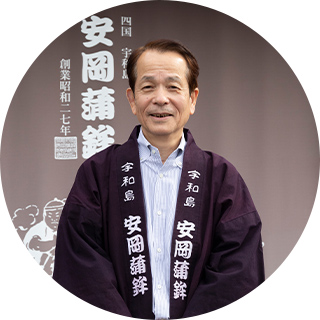 Second Generation Hajime Yasuoka
Second Generation Hajime YasuokaTel:0895-58-2155 Fax:0895-58-2706












